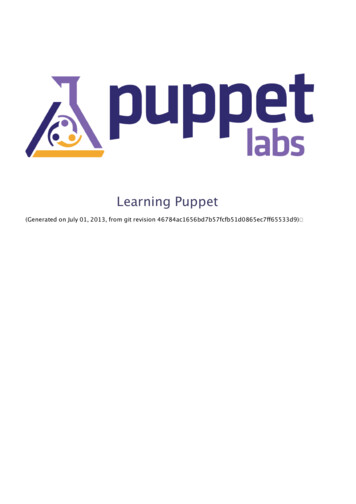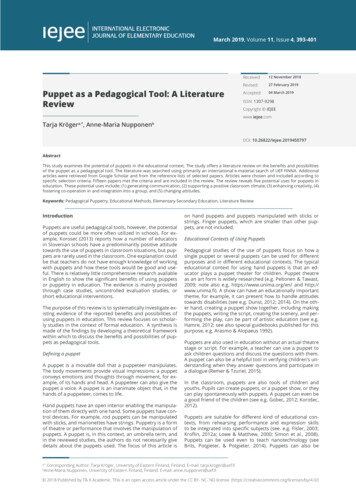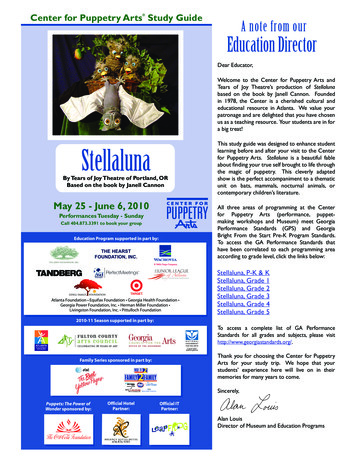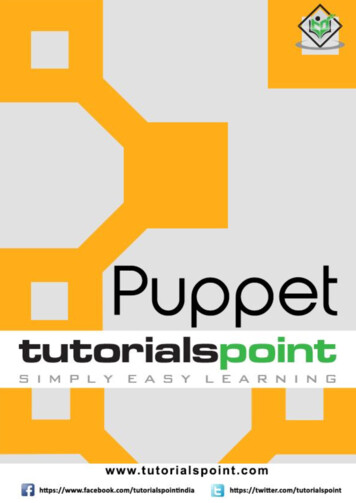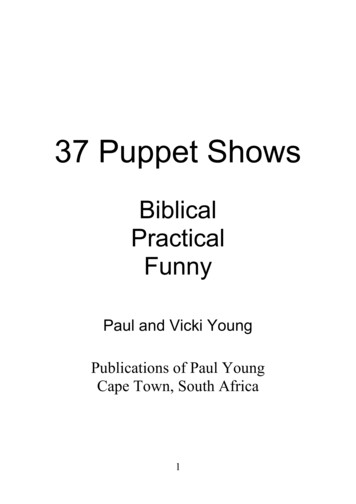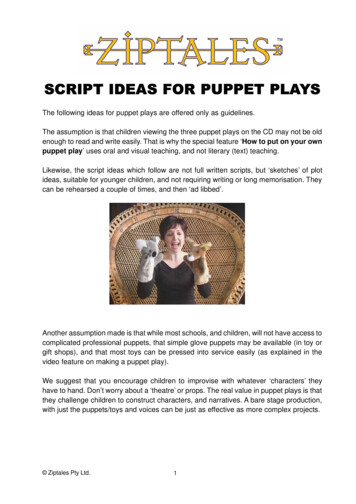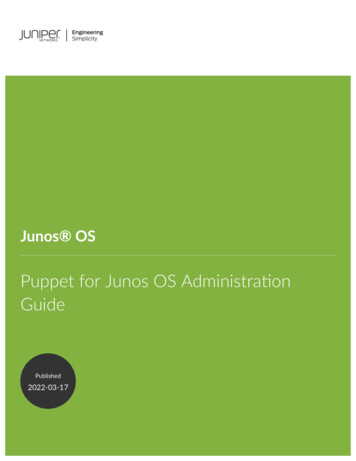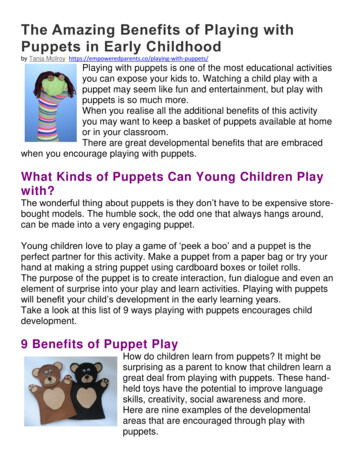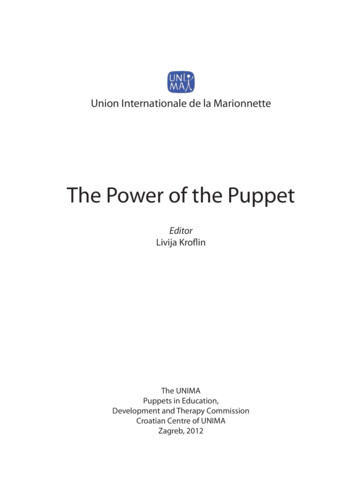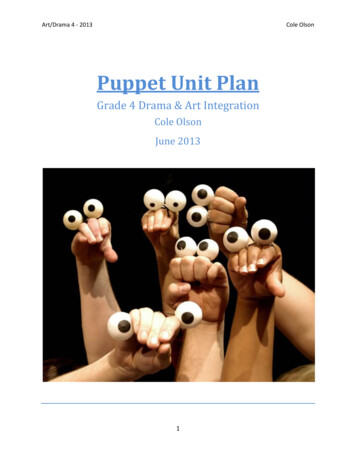
Transcription
Art/Drama 4 - 2013Cole OlsonPuppet Unit PlanGrade 4 Drama & Art IntegrationCole OlsonJune 20131
Art/Drama 4 - 2013Cole OlsonTable of ContentsEssential Questions and UnderstandingsPage 3Unit OutcomesPage 4Unit RationalePage 5Unit Assessment PlanPage 6Unit SummaryPage 7Lesson SummariesPage 8Lesson Plan 1Page 9Lesson Plan 2Page 12Lesson Plan 3Page 15Lesson Plan 4Page 17Puppet Planning HandoutPage 202
Art/Drama 4 - 2013Cole OlsonART/Drama : Puppet Creation and Inanimate Object AnimationTRANSFER GOALEstablishedGoalsStudents will:-Create anddecoratemeaningfulandthoughtfulpuppets.-Use speechandmovement togive life topuppets.-Use puppetsto find a voiceforthemselves.-Use puppetsto act withotherstudent’spuppets.-Students will combine a comfort in dramatic play and artistic creation to createpersonalized and meaningful puppets, and through speech and movement animatethem to interact on their own and with other puppets.MEANINGEnduring Understandings:Essential Questions:Students will understand that Students will keep considering U1 – Meaning can be created in puppetsthrough thoughtful choices of colour, shapesand aesthetic features.Q 1 – What techniques can bring nonalive objects to life?U2 – There are multiple types of puppetsthat can be created.Q2 – What features can be added to apuppet to create meaning?Q3 – How a puppet can tell a storythat a human cannot.U3 – Speech and movement can be used tobring inanimate objects to life.ACQUISITION OF KNOWLEDGE & SKILLSStudents will know Students will be skilled at - What a puppet is and how to create- Making puppets with a personalsock, paper and found object puppets. meaning.-How to create life in inanimateobjects.-How to create meaning through apuppets creation and manipulation.-Giving life to puppets.-Expressing thoughts and feelingsthrough any object.STAGE 2 – EvidenceEvaluative CriteriaPerformance is judged in terms of:-Participation-Discussions-Paper Puppet-Found Object Puppet-Being Elmo Reflection-Sock Puppet PlaysAssessment EvidenceStudents will need to show their learning by:Students will show learning by engaging in active class discussions andoffering input and thoughts about puppets and puppet theatre. They willshow art and drama understanding by creating a number of puppets out of avariety of objects, and animating them in a series of workshops, monologuesand short plays.3
Art/Drama 4 - 2013Cole OlsonUnit OutcomesGENERAL LEARNING OUTCOMES:Art-Students will receive a complete set of experiences about art through the four components ofreflection, depiction, composition and expression.Drama-To acquire knowledge of self and others that results from reflecting on dramatic play.To develop competency in communication skills through drama.To foster an appreciation for drama as an art form.SPECIFIC LEARNING OUTCOMESArt Students will assess the visual qualities of objects.Students will interpret artworks by examining their context and less visible characteristics.Students will select appropriate references for depicting.Students will create emphasis by the treatment of forms and qualities.Students will create unity by interrelating the parts of a composition.Students will decorate items personally created.Students will create an original composition, object or space based on supplied motivation.Drama become aware of the puppet as a communicative medium by: moving as a puppet moving another as a puppet constructing a simple puppetapply speaking skills to puppetry by: communicating through the puppet as an extension of self responding to another puppet creating dialogueapply moving skills to puppetry by: experimenting with puppet manipulation exploring and creating various environments through which the child can move the puppetapply dramatization skills to puppetry by: creating a character for a puppet creating an environment in which the character will react expressing feelings as a puppet working with others to create a puppet story4
Art/Drama 4 - 2013Cole OlsonUnit RationaleI chose to do my own unit on puppet making, while exploring the grade 4 dramacurriculum that focuses on puppetry. I wanted to combine the drama and art curriculumstogether, as I believe the making of a puppet to create a character and manipulate it in anenvironment takes students first through the art curriculum as they make a character, andthen the drama curriculum as they learn to act and react with their puppet. I believepuppetry is a great unit for art integration, as it gives students a chance to use their artisticskills to create the prop they will be using for their dramatic exploration.For many younger students, finding a voice for themselves can be a challenge inschool with so many other peers around them. I believe puppetry is a very valid form ofboth art and dramatic expression, as it allows students the chance to build an item that hasmeaning and uniqueness to them, and through that they can speak in such a way that theyotherwise could not on their own. With a puppet, a student can express thoughts and ideasand have them voiced through a mouth that is not their own, but rather an extension ofthemselves. Puppetry is especially useful at this age, as it encourages students to find thisvoice that is not their own in a playful and engaging manner.The elementary drama curriculum lends itself well to this unit, as it states that theoutcomes and learner objectives it gives are guidelines but not necessary for students tocomplete. Because many schools cannot do drama, teachers that have the luxury to utilizethe curriculum are able to pick and chose strong objectives that they believe will lead totheir students having a powerful engagement in dramatic play. The puppetry unit is veryopen ended, and due to its casual nature it is a perfect match with the art curriculum. Asstudents create, decorate, explore and represent ideas through artistic choices, they willsimultaneously be creating both art and drama. This unit really captures the ideas of artintegration, and allows for students to take one simple activity and discover a multitude ofskills and growth through it.5
Art/Drama 4 - 2013Cole OlsonUnit Assessment PlanMethod htingTypeCritiquesand ndance& ing ElmoReflectionChecklist10SummativeSock Puppet& PlaysRubric35SummativeSock PuppetPlanningChecklist5Summative344Students will be evaluated on the standard 5 point scale as seen in the Elementary Report Card(5 - Excellent, 4 - Very Good, 3 - Satisfactory, 2- Improvement Needed,1 - Unsatisfactory)6
Art/Drama 4 - 2013Cole OlsonUnit SummaryTo introduce students to puppets, I plan to first introduce them to a former masterin the puppet industry and the creator of the Muppets, Jim Henson. I have an excellentYouTube video selected that shows Jim explain what puppetry is, how to make numerousdifferent simple puppets, and how to bring these creations to life. This is a great startingpoint, as it covers all the main themes of the unit. I have broken my unit into 4 separatelessons, each of which will take a number of classes to complete. The first will havestudents watch the video and be introduced to puppet making, and will have them createsimple folded paper puppets to try playing with. They will decorate them to work with theart curriculum, and then create a voice for them to hit the drama objectives. The next partof the lesson will have students make puppets out of a found object. Each will bring anobject to create a character, and they will have to rationalize why they chose this object.Students will create this new puppet, and then use them to tell a story on a puppet stage.Following this, I plan to show students the film “Being Elmo” to show them how thecharacter was created, and how they can create their own characters that mean somethingto them. They will then plan out a character they want to create to begin thinking aboutwhat kind of characteristics they will give to their creation. The next section of the unit willhave them use their information sheets to create a sock puppet, and from there they willput on a small play with a number of other students for an ECS classroom. They will be incharge of writing a short script that incorporates a beginning, middle and end. This willthen allow students to approach the art curriculum by learning how to create a multitudeof puppets, and will explore the drama curriculum by having students create charactersand act through the puppets themselves. I believe it will be a great way to integrate art intothe curriculum, while allowing students to explore and have a lot of fun.This unit touches on art history as we look at puppets that are easily created, andthat have relevance in both contemporary culture and past culture. The main history focusis Jim Henson, and his creation of the Muppets in 1955. A studio activity of presenting apuppet play to young students will be included, as well as a reflection on a documentaryabout the character Elmo. Students will reflect on the growth of the character, and how artand drama contributed to the national sensation. Psychomotor skills are addressedthrough the manipulation of clothe, paper and found objects to make puppets and thenmanipulate them to create life in them. Elements of design are also touched upon, asstudent will need to apply aesthetic choices to give meaning to their puppet to help bringthe character to life. This unit combines the elements of art and drama to give students anentire artistic experience while exploring the art of puppetry.7
Art/Drama 4 - 2013Cole OlsonLesson Plan Summaries (40 minute classes)Introduction to Puppets (2 classes)Students will begin by being introduced to puppets, and will be given a brief look at differenttypes of puppet making techniques and animation ideas. The lesson will be focused around thepuppeteer Jim Henson, and students will receive information about Jim’s career that led to thecreation of the Muppets. This lesson will then look at a YouTube clip that shows Jim giving abrief demonstration on simple puppets. Afterwards, students will make simple paper mouthsthat can be manipulated with their hands, and will interact with other classmates’ puppets.Hand Puppets (3 classes)Students will next focus found object puppets. They will make hand puppets as shown by JimHenson, and will be required to bring one object from home they want to be the focus of theirpuppet. To introduce students to the ideas of reusing and recycling, no new materials will bepurchased for these puppets. Students will be required to use found objects for their entirepuppet. Numerous examples are given in the video by Jim Henson to give students ideas.Students will then have time to create their puppets, and prepare a short monologue for themto introduce themselves to the rest of the class on a small puppet stage. The students willpresent their puppets and reflect on the experience.Being Elmo (2 classes)Students will next watch the documentary Being Elmo. The focus of this lesson will be oncreation of a character, and students should pay close attention to the transformation of thecharacter of Elmo. After the video, students will write a short reflection on the video to behanded in for assessment.Sock Puppet Plays (6 classes)Students will next use their brainstormed ideas to create a sock puppet character. Students cancreate any character, human or animal, that they wish. They will do a final draft of the puppet’scharacteristics on a handout for evaluation. This handout will have students think about manydifferent aspects of their puppet and answer numerous questions about their characteristicsand lives. Students will then create short plays in groups of 3 or 4 and present them to an ECSclassroom. Students will after show the ECS students how they made the puppets, and howthey used art and drama to make their plays for them.8
Art/Drama 4 - 2013Cole OlsonLesson 1Paper Puppets – 2 classesDramaGeneralOutcomesStudents will:- Acquire knowledge of self and others that results from dramatic play.- Develop competency in communication skills through drama.- Animate an inanimate paper object through movement and speech.ArtGeneralOutcomesStudents will:- Receive a complete set of experiences about art through the four componentsof reflection, depiction, composition and expression.- Use colours, shapes and lines to explore choices in creating a puppet.DramaLearningObjectivesStudents will:- Identify how puppets can be brought to life.- Create characters for puppets using movement and speech.- Use their puppets to interact with other students.- Develop a comfort for speaking through an inanimate object.ArtLearningObjectivesStudents will:- Identify how to create multiple types of puppets.- Observe different puppets to find elements of colour, shape and line.- Familiarize themselves with different puppet artists.- Make informed decisions while creating a puppet to express motivations.Assessment-Formative: Observation, Class discussionSummative: Paper PuppetMaterialsSmartboard/projector, YouTube Jim Henson Clip, PowerPoint presentation,paper, tape, markers, googly eyes, glue, Drama journalsTeachingStrategiesDiscussion, Lecture, Demonstration, Hands-on Activity, ExplorationIntroduction(20 min)The introduction will take up one class, and the next part of this lesson will takeplace on the following lesson. Students will enter the drama classroom and sitviewing the Smartboard, where the introductory activity to puppetry will beshown. Have students take out their drama journals, and begin by having thembrainstorm what puppets and puppetry are. Have any students ever seen a livepuppet? What shows have they seen that use puppets? Students will write downthe definitions for puppetry, animation and inanimate objects in their journals forreference.Students will then go through the PowerPoint presentation up to the fifth slide.They will watch the video by Jim Henson, and then talk about what they’ve seen.Ask students to brainstorm the types of puppets that they saw. Inform them thatthey will be creating the paper puppets, the puppets made of found objects thatuse their hands, and a sock puppet. Show the following pictures from the slidesand pose to students these questions:9
Art/Drama 4 - 2013Cole Olson What kinds of puppets did you see?What materials can puppets be made of?How can we move puppets and animate them?How can we make puppets look like they’re alive? What shapes do you see in the puppets?What colours do you see?What textures and lines can you see?What kind of feeling do the puppets give off?What other things do you notice about these puppets?Inform the students that the following class will have them create and decoratesimple paper puppets, and use them to interact with other students.Body(90 min)Students will enter the classroom and do a quick recap of the video they saw theprevious day. They will continue with paper puppets first by creating a simpleshape they will use for a puppet head. The shape is similar to paper fortunetellers, but taped on the sides to create a stable mouth. Students will be shown thefollowing video of how to fold the paper:http://www.youtube.com/watch?v XAcYGX58cioEvery student will be given a white square of paper. As a group, the teacher will gothrough a guided demonstration to show every student how to properly fold andtape their puppets. Following the demonstration, students will be given 10minutes to glue on googly eyes, draw features, and put on other attachments tocreate a simple paper character. Have students give their puppets a name, andonce everyone is finished, have them gather in a circle.10
Art/Drama 4 - 2013Cole OlsonHave students wander around the classroom with their puppets on their hands.As they walk, have them first say hello to every puppet that they pass by.Following that, have them introduce themselves with their names as they passanother puppet. Following this, have students partner up with the closest studentto them for the next activity.Students will be given a few moments to talk through their puppets and tell theother student’s puppet about themselves. Have students talk about the puppetsbackground and personal life. Encourage them to come up with ideas about:- Family life- Where they live- Their favorite hobbies- Favorite food- Where they work- Ect.After each student introduces themselves, they will separate and look for a newpartner to talk about themselves to. By the end of the class, students should becomfortable talking through their puppet, and should have a pretty goodunderstanding of their character.Closure(10 min)Before students exit, have them rip out a page of their journal. They are to writetheir names on them, and write down as much as they can about the puppet theycreated. Whatever they used as information to introduce themselves to otherpuppets should be included. Have students write their names on their puppets aswell, and have them hand in the puppets and journal sheets with their puppetinformation. These two pieces will be used as assessment for this lesson, and willbe used for summative assessment. They will be worth 25% of the unit.SpongeActivityHave students who finish early fold and create a second paper puppet withdifferent colours, shapes and aesthetics to create a second character.11
Art/Drama 4 - 2013Cole OlsonLesson 2Hand Puppets – 3 classesDramaGeneralOutcomesStudents will:- Acquire knowledge of self and others that results from dramatic play.- Develop competency in communication skills through drama.- Animate an inanimate object through movement and speech.ArtGeneralOutcomesStudents will:- Receive a complete set of experiences about art through the four componentsof reflection, depiction, composition and expression.- Use colours, shapes and lines to explore choices in creating a puppet.DramaLearningObjectivesStudents will:- Identify how objects can be transformed into puppets.- Create characters for puppets using movement and speech.- Use their puppets to find a unique and purposeful voice.- Develop a comfort for speaking through an inanimate object.ArtLearningObjectivesStudents will:- Learn how to transform everyday items into puppets.- Observe other hand puppets to see what choices their artist’s made.- Justify artistic creation choices about puppet materials.- Make informed decisions while creating a puppet to express motivations.Assessment-Formative: Observation, Class discussionSummative: Hand PuppetMaterialsSmartboard/projector, Variety of recycled objects, paper, tape, glue, googly eyes,black fabric, stringTeachingStrategiesDiscussion, Lecture, Demonstration, Hands-on Activity, Exploration, PresentationIntroduction(20 min)Students will begin by brainstorming a list on the whiteboard or Smartboard.They will have to come up with as many ideas of objects they can use to createtheir own puppets. Students will review the ideas of the last lesson and the videoby going over what a hand puppet is and how they are manipulated. Slides 8 and 9of the PowerPoint will be used at this point to get students thinking about the ideaof hand puppets and what can be attained through them. Ask the following:12
Art/Drama 4 - 2013Cole Olson How is this puppet being manipulated?How can you give this puppet life-like characteristics?What can you add to a hand puppet to give it real characteristics?What would you decorate this simple puppet with to give it personality?Follow by going to the 9th slide and asking the following questions: What can these puppets be used for?What kind of feelings do these puppets give you?Why did the artist make them this specific way?How are these two puppets similar? How are they different?Why did the artist make these puppets?Inform students that they will next be creating their own hand puppets out offound objects. Leading up to this class, be sure to be gathering recyclablematerials, and even borrow recycling from other classes in the school. Stress theimportance of recycling and reusing materials by explaining to students thatpuppets can be made of unwanted materials to create a beautiful and artisticcreation. Students will be required to incorporate one found object somewhere ontheir hand puppet.Body(95 min)ACTIVITY 1 – PUPPET CREATIONStudents will begin by taking the rest of the first class (20 min) to beginconstructing their puppets. Students will be given the chance to find their onefound object for the hand puppet. Students can also bring an item from home forthe next class if they have a particular object in mind. Give a demonstration ofhow to create a usable head using a tennis ball, a functioning body with an old rag,and hands with pieces of cardboard. This can be shown to students so they havethe basic knowledge of how to create a body, head and hands.The next class, students will have the first 20 minutes to finish working on theirpuppets. Final touches will be added to the puppets, and if students do not finishthey will have to find time to finish them later. The second part of the class willhave students look at creating a small introduction for their puppet. Students willbe given the remaining 20 minutes to begin planning their short speech. Eachshould range from 30 seconds to a minute. Students will be given a piece of blackfabric along a string that will act as a puppet stage. Students will use the rest ofthe class to plan and start rehearsing. Stress to students the importance ofthinking through all aspects of a character including their name, age, lifestyle,family, job and other details in order to make a full presentation.13
Art/Drama 4 - 2013Cole OlsonACTIVITY 2 – PUPPET PLAYSThe last class will begin with a short 10 minute period to finish practicingspeeches. After that, students will create an audience as the puppet stage made ofthe black clothe on the string is set up. Each student will hide their bodies behindthe clothe, and use their puppets to act using speech and voice. Students will givetheir quick introduction speech to tell the class who they are and a little aboutthemselves. This activity is designed to allow students to manipulate the artworkthey have created, as well as learn to speak through another medium. After eachspeech, the students will show their support by applauding. Students will be giventhe last 5 minutes of the class for discussion.Closure(5 min)The class will end with a short discussion. Have students discuss the following:1. Why did we perform these short introductions?2. How did you transform your puppet from a piece of art into a living,breathing object?3. As the artist, what meaning did you want the puppet to show?4. What did you add to your puppet in order to create the character youwanted?5. What found object did you use in your puppet?Students will hand in their puppets when leaving the class, and they will be usedfor summative assessment. The presentation will not be marked, but countedtoward the effort assessment. The puppet will be weighed at 25%.14
Art/Drama 4 - 2013Cole OlsonLesson 3Being Elmo – 2 classesDramaGeneralOutcomesStudents will:- Develop competency in communication skills through drama.- To foster an appreciation for drama as an art form.- Learn how to create dynamic characters with meaning in inanimate objects.ArtGeneralOutcomesStudents will:- Receive a complete set of experiences about art through the four componentsof reflection, depiction, composition and expression.- Learn how aesthetic elements can be utilized to create expression andmeaning.DramaLearningObjectivesStudents will:- Identify what makes a strong character.- Learn how to create more authentic and realistic movement in a puppet.- Learn the importance puppets can play in people’s lives.- Appreciate puppetry as an art form.ArtLearningObjectivesStudents will:- Learn how to create realistic and meaningful creations.- Learn how art projects can affect people’s lives.- Make informed decisions while creating a puppet to express motivations.Assessment-Formative: Observation, Class discussionSummative: Being Elmo ReflectionMaterialsBeing Elmo Video, Projector/T.V., Drama Journals, PaperTeachingStrategiesDiscussion, Video, ReflectionIntroduction(5 min)Students will enter the class and sit in a comfortable position while the projectoror T.V. is set up. Students will be informed that for the next two classes they willbe watching a puppet documentary called Being Elmo. Students will be told to payattention to the film, as they will complete a reflection after the film. Studentsshould be told to focus especially on the transformation of Elmo.Body(75 min)ACTIVITY 1 – Being ElmoStudents will spend the rest of the class watching Being Elmo. Any part of the filmthat is not finished will be watched in the next class. This is a short documentary,so it should easily be finished in the two classes.ACTIVITY 2 - ReflectionStudents will complete a short paragraph reflection in their drama journals oncethe video is complete. The PowerPoint should display slides 10 and 11, and thequestions from the PowerPoint will be projected for students. These questionsare:15
Art/Drama 4 - 2013Cole Olson1. How did the puppeteer make Elmo come to life?2. How did the change in Elmo’s character make you feel? What changed aboutElmo over time?3. How did the artists create the puppets in the movie?4. Do you think puppetry has value in it? Is it an important art to perform? Why orwhy not?Give the students the remainder of class to finish their reflection. Inform themthey will be marked, so they should try and include at least 1 sentence for eachquestion. Students should aim for a 1 paragraph reflection.Closure(5 min)The class will end with a short discussion about the question. Students can taketime to express their ideas about the movie, and how puppetry fits in to both artand drama. Students will hand in their reflections before they leave to beassessed. The reflections will be weighed at 10% of the unit’s mark.SpongeActivityStudents who finish early will be asked to use a spare piece in their dramajournals to use words or pictures to try and figure out how Elmo is manipulatedby the puppeteer.16
Art/Drama 4 - 2013Lesson ngObjectivesArtLearningObjectivesAssessmentCole OlsonSock Puppets – 6 classesStudents will:- To acquire knowledge of self and others that results from reflecting ondramatic play.- To develop competency in communication skills through drama.- To foster an appreciation for drama as an art form.- Create dynamic and unique characters and use them to act out a story.Students will:- Receive a complete set of experiences about art through the four componentsof reflection, depiction, composition and expression.- Apply meaning and emotion to inanimate objects through the use of aestheticchoices.- Understand how artwork can be transformed into living objects.Students will:- Create unique characters with detailed lives.- Apply movement and speech to enhance their puppet characters.- Create a short play with a beginning, middle and ending.- Perform for an audience with their puppets.- Appreciate puppetry as an art form.Students will:- Learn how to create realistic and meaningful creations.- Learn how art projects can affect people’s lives.- Make informed aesthetic decisions that compliment planning of a character.-Formative: Observation, Class discussionSummative: Sock Puppets, Sock Puppet PresentationMaterialsSocks for every student, art supplies, scissors, felt, glue, googly eyes, black fabric,string, Character Handouts for every student, Drama journalsTeachingStrategiesDiscussion, Lecture, Exploration, Rehearsal, PresentationIntroduction(20 min)Students will begin by looking at slides 12, 13 and 14 of the PowerPoint. As theyview each slide, reflect on the following questions:17
Art/Drama 4 - 2013Cole Olson What give these puppets lifelike qualities? What feeling do these puppets give you? How could you use these puppets to create a positive feeling for someoneelse? What could you do to make these puppets come to life?Following that discussion, go to the final slide and discuss the following: What might this puppet be called?Where is it from? How old is it?What kind of personality does it have?How was this puppet made?What feelings do you think the artist wanted to express through thispuppet?Have students try and answer the questions with reference to ideas they learnedin the Being Elmo video. Students should by now realize that puppetry is acombination of both art and drama skills. Be sure that students are makingreference to the fact that they need art in order to create the characters that theyare bringing to life with dramatic skills. Students should have an appreciation ofboth art and drama curriculums, as puppetry allows them to explore both arts.Body(200 min)ACTIVITY 1 – Puppet PlanningStudents will end the first class by planning their puppets. They will be given ashort handout that can be found below this lesson. Students will spend theremainder of the class planning out their puppet, and coming up with thebackground so they can start creating their character next class.ACTIVITY 2 – Sock Puppet CreationFor the next section of the lesson, students will have one whole class to work ontheir sock puppets. Each student will be given one sock, and they must use theinformation they wrote down on their planning sheets to create their characters.Students should make connections between their planning and artistic choices inthe creation of the characters. Students who do not finish in class will have tocomplete their puppets before the next class. Students will hand in their planningsheets for summative assessment at the end of the class. Sheets will be worth 5%.ACTIVITY 3 – Sock Puppet Play PlanningStudents will next be given 3
Puppet Rubric 1 25 Summative Found Object Puppet Rubric 2 25 Summative Being Elmo Reflection 3 Checklist 10 Summative Sock Puppet & Plays 4 Rubric 35 Summative Sock Puppet Planning Checklist 4 5 Summative Students will be evaluated on the sta
